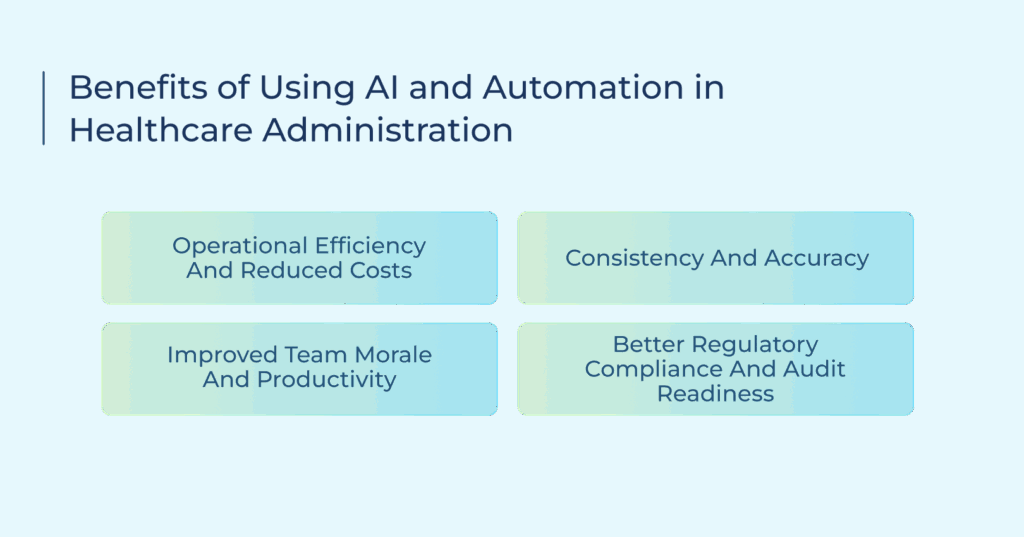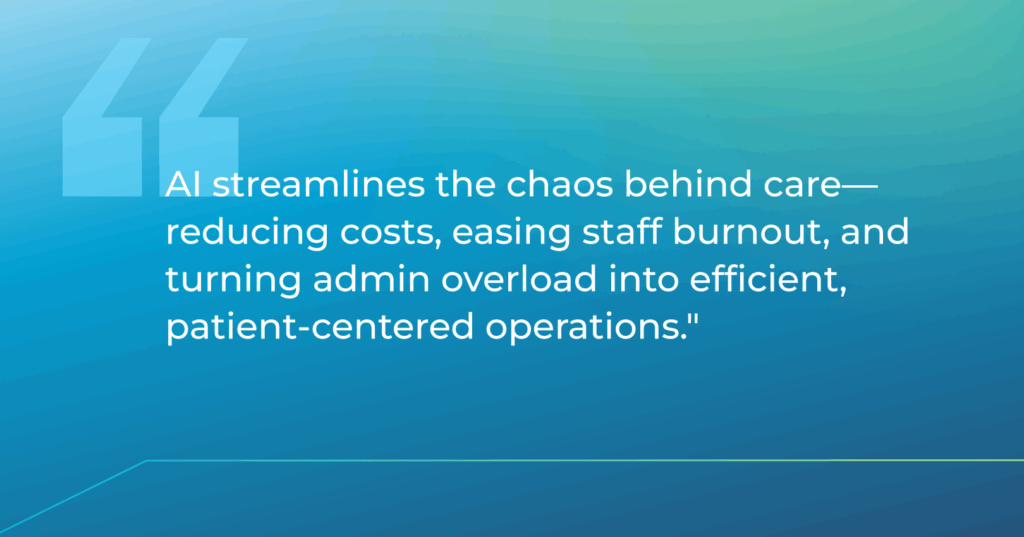Last flu season claimed the lives of more than 200 children in the United States,…

AI & Automation in Healthcare Administration: Improving Operations & Reducing Costs
Hospitals and clinics run on paperwork, scheduling, follow-ups, billing, and a thousand tiny tasks that eat up time and resources. That’s where AI is stepping in, not to replace your workforce, but to remove the repetitive work that slows them down.
We’re talking healthcare administration that’s faster, smarter, and with fewer headaches.
In this post, we’re looking at how AI in healthcare administration is already changing the day-to-day. We’ll explore real-world generative AI applications that handle everything from documentation to patient communication, and show how it’s helping practices cut costs without cutting corners.
If you’re wondering what practical, working AI looks like behind the scenes in healthcare, you’re in the right place.
The Need for AI Solutions for Healthcare Administration
Healthcare is facing an administrative crisis. Hospitals and clinics are running short on staff, but the administrative workload keeps growing. The people who are left spend way too much time on forms, billing codes, and compliance reports instead of actually supporting patient care.
Insurance companies keep making their approval processes more complicated, which means claims sit in limbo for weeks while healthcare organizations wait for their money. On top of that, regulations change constantly, and keeping up with all the new rules eats up even more time than should go to patient care.
This affects everyone. Patients can’t get appointments because someone has to spend hours getting insurance approval first. Nurses who should be helping people are stuck at computers, filling out the same information in five different systems. Doctors delay treatments because the prior authorization paperwork isn’t done yet.
You can’t solve this by just hiring more people, and neither can you force the current staff to work longer hours. They’re already at their tipping points.
That’s why AI with automation is the only way forward now. Healthcare organizations that don’t figure this out will keep getting buried under more paperwork while their patients sit around waiting. There’s no other way to deal with all this work without either making patients wait even longer or pushing the staff you still have until they quit as well.
Key Applications of AI and Automation in Healthcare Administration
Healthcare organizations aren’t waiting around to see if AI works. They’re already using it and getting real results. Hospitals and clinics are cutting billing time in half, getting patients to show up for appointments more often, and freeing up staff to do the work that actually matters. Here’s what’s working right now.
Effective Patient Engagement and Communication
Your staff spends too much time repeating the same messages day after day. With AI in healthcare, that’s no longer necessary. AI and automation handle all of that automatically. Appointment reminders are sent out to the most appropriate channels. Patients get automatic follow-up messages after every visit.
The real magic lies in smart patient engagement. The real magic lies in smart patient engagement. With AI, patients can text a question anytime, 24/7, and get instant, accurate responses on everything from billing and care instructions to appointments, prescriptions, and more. It’s fast, convenient, and always available when they need it.
Assistance in Medical Billing Claims Processing
Smart billing solutions use automation to send out invoices, reminders, and even process payments, reducing most of your daily admin burden. If patients have any billing questions, AI-driven IVAs can easily step in to answer them and send secure billing links. The system will guide patients through the entire process without needing any live human agent.
Calendar Optimization Through Automated Appointment Scheduling
Automated scheduling considers multiple factors that humans can miss. There are the provider availability, appointment type requirements, patient history, travel, etc. The system automatically fills cancellation slots with patients from waiting lists, prioritizing urgent cases or those who’ve been waiting longest.
Workflow Automation
With automation in place, repetitive administrative tasks run automatically without human intervention. Patient intake forms get processed, and the data flows directly into the EHR system.
Patient intake forms are processed automatically, with the data flowing straight into your EHR. Lab results are routed to the right doctor, insurance updates go directly to billing, and patient messages are sorted by urgency.
Prior Authorizations and Insurance Verification
Insurance verification and intake don’t have to be a bottleneck. With the right digital tools, patients can fill out everything before even coming into the office.
For example, they can fill out their information, confirm insurance, sign documents, and even process copays, all from their phone or computer.
The system gathers everything in advance and pushes it directly into the patient’s record. It’s intelligent automation that conserves time on both sides and keeps the appointment on schedule from the minute it’s scheduled.
AI Virtual Assistants for Self-Service
Patients can connect with AI through your website, SMS, or voice to get answers to simple questions without having to call your office. They may, for instance, wish to inquire if they can bring their service dog, which insurance you accept, or if you offer evening appointments.
The system knows your policies and can give directions to different departments or explain what to bring for a procedure or test.
The more advanced virtual assistants let patients schedule their own appointments, request prescription refills, or cancel visits just by typing normally. This self-service means your front desk gets fewer phone calls asking the same ten questions every day.
Benefits of Using AI and Automation in Healthcare Administration
Healthcare organizations aren’t just experimenting with automation. They’re getting measurable improvements that show up in their budgets and daily operations. The benefits go beyond just saving time.
AI virtual assistants can answer patient questions, send reminders, and give instructions in their preferred language. Everything else is handled by automation behind the scenes.

Operational Efficiency and Reduced Costs
Claims that took your billing team days to process get done in hours. Staff who spent mornings calling about appointments can help patients with complex problems instead.
When scheduling and basic communication are automated, you need fewer people to handle the same number of patients. The money you save on administrative salaries often pays for the automation system within the first year.
Improved Team Morale and Productivity
When automation takes over repetitive tasks, it allows your staff to do the work they actually trained for. So, medical assistants spend more time with patients instead of updating forms. Your billing specialists can be sent to handle complicated cases instead of being overwhelmed with routine claims.
The meaningful work also translates into higher job satisfaction, not just improved productivity. It’s a simple fact: teams that aren’t constantly stressed about getting through paperwork provide better patient care.
Consistency and Accuracy
Making mistakes is what makes us human. Your front desk will eventually discover that their rejected claim was because someone entered the wrong billing code.
Automation-led healthcare administration, however, is not prone to making such mistakes. You get accuracy and consistency, which means fewer errors, fewer delays, and less time spent on cleaning up after avoidable mistakes.
Better Regulatory Compliance and Audit Readiness
Staying compliant is a lot easier when nothing slips through the cracks. With automation in place, every message, claim, and update is automatically recorded and organized. You no longer have to chase files or dig through mountains of paperwork and folders when it’s audit time.
Even better, the system flags potential compliance issues before they turn into real problems. So, you’re not reacting after the fact, you’re staying ahead of it, with everything you need already in place when auditors come knocking.
The AI Challenges and How to Address Them
Healthcare organizations want AI benefits, but may hit roadblocks during implementation. Privacy regulations, old systems, and untrained or resistant staff create problems that slow down progress. The organizations that succeed plan ahead and pick the right technology partners.
Data Privacy, Security, and Compliance
Healthcare data breaches cost organizations millions of dollars on average. With patient information being a gold mine for hackers, healthcare management is constantly concerned about where that data is stored, who can access it, and how it’s being safeguarded by AI systems. That’s why every AI tool must comply with HIPAA regulations.
TeleVox addresses these concerns through an enterprise-grade security infrastructure. Their whole system runs in HIPAA-approved environments, and you can control exactly who can see your patients’ information. In addition to data encryption at all times, the system automatically keeps detailed logs of all activity to make compliance audits easier.
Integration Challenges
Most healthcare computer systems are old and weren’t built to work with AI. Your electronic health records talk to your billing system, but getting them to share information with new AI tools? That’s where things get messy. IT departments can spend months trying to connect systems that speak different languages.
TeleVox connects to the major EHR systems healthcare organizations already use: Epic, Cerner, Allscripts, and others. Their technical team helps with setup instead of leaving you to figure it out alone. The platform works with your current processes rather than forcing you to change everything.
Change Management and Staff Resistance
Healthcare workers worry about AI taking over their jobs. They’ve spent years building relationships with patients and don’t want a computer handling those conversations. Some staff members avoid new technology, while others fear they’ll lose control over patient care decisions.
TeleVox designed their interface to feel familiar, not foreign. Your staff can review AI-generated messages before they go out to patients, making sure they are personalized. Start small with simple appointment reminders, and then gradually add more complex tasks as your team gets comfortable. The goal is to use AI as an assistant without losing the human touch.
Resistance and Friction from the Patients
Patients don’t always trust AI with their healthcare communications. Some prefer talking to real people about medical issues, while others get confused by automated systems. Language barriers and technology comfort levels create additional hurdles.
TeleVox tells patients when AI is handling their communication and gives them easy ways to reach human staff when needed. The platform works in multiple languages and lets patients choose how they want to communicate. If someone has a complex question, the system passes them to a real person (specialist) right away.
Mapping the ROI
Hospital executives need proof that AI investments pay off. However, traditional financial analysis often misses some benefits, like happier patients or less stressed staff. Additionally, administrators struggle to show leadership concrete numbers that justify spending money on AI technology.
TeleVox helps by tracking the metrics that matter to healthcare administrators. You can see how much time staff save, how many fewer patients skip appointments, and how much money you save on phone calls. The dashboard shows real numbers you can take to your board meetings. Organizations typically see positive returns within the first year.
Addressing the Ethical Concerns
AI bias, transparency, and accountability create ethical challenges in healthcare settings. This makes it important for healthcare organizations to have clear policies around AI oversight, bias detection, and human intervention protocols.
TeleVox tests their AI regularly to catch bias before it affects patients. The system explains why it made specific decisions, so you can review the reasoning. Human oversight stays built into the workflow, and patients always know when AI is involved in their care. Every decision gets logged so you can audit the system’s performance over time.

Experience the Future of Healthcare Administration With TeleVox
Imagine a healthcare office where paperwork doesn’t pile up, staff aren’t tied to phones all day, and patients actually feel heard. That’s not some distant vision. That’s what TeleVox is making possible right now.
By blending automation with real intelligence, TeleVox transforms everyday admin tasks into efficient, hands-off processes that still feel personal. Appointment reminders go out without delay. Patient follow-ups are consistent and thoughtful. Most importantly, your team is finally free to focus on what they do best: caring for their patients.
It’s not just about cutting costs (though you’ll do that too). It’s about creating a system that works smarter, not harder. One that’s scalable, intuitive, and built for the complexities of modern healthcare.
If you’re ready to see what the future of healthcare administration actually looks like in practice, now’s the time. Book a demo today and see the difference for yourself.



